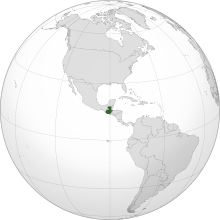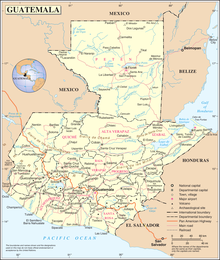
A | B | C | D | E | F | G | H | CH | I | J | K | L | M | N | O | P | Q | R | S | T | U | V | W | X | Y | Z | 0 | 1 | 2 | 3 | 4 | 5 | 6 | 7 | 8 | 9
Republic of Guatemala República de Guatemala (Spanish) | |
|---|---|
| Motto: Libre crezca fecundo[1] (Spanish) "Grow Free and Fecund" | |
| Anthem: Himno Nacional de Guatemala (English: "National Anthem of Guatemala") | |
| March: La Granadera (English: "The Song of the Grenadier") | |
| Capital and largest city | Guatemala City 14°38′N 90°30′W / 14.633°N 90.500°W |
| Official languages | Spanish |
| Recognised national languages | Mayan |
| Recognised regional languages | |
| Ethnic groups (2018[2]) | |
| Religion (2017)[3] |
|
| Demonym(s) | Guatemalan Chapín |
| Government | Unitary presidential republic |
| Bernardo Arévalo | |
| Karin Herrera | |
| Nery Ramos | |
| Legislature | Congress of the Republic |
| Independence | |
• Declared from the Spanish Empire | 15 September 1821 |
• Declared from the First Mexican Empire | 1 July 1823 |
• Declared from the Federal Republic of Central America | 17 April 1839 |
• Current constitution | 31 May 1985 |
| Area | |
• Total | 108,889 km2 (42,042 sq mi) (105th) |
• Water (%) | 0.4 |
| Population | |
• 2023 estimate | 17,980,803[4] (69th) |
• Density | 129/km2 (334.1/sq mi) (85th) |
| GDP (PPP) | 2024 estimate |
• Total | |
• Per capita | |
| GDP (nominal) | 2024 estimate |
• Total | |
• Per capita | |
| Gini (2014) | 48.3[6] high |
| HDI (2022) | medium (136th) |
| Currency | Quetzal (GTQ) |
| Time zone | UTC−6 (CST) |
| Date format | dd/mm/yyyy |
| Driving side | right |
| Calling code | +502 |
| ISO 3166 code | GT |
| Internet TLD | .gt |
Guatemala,[a] officially the Republic of Guatemala,[b] is a country in Central America. It is bordered to the north and west by Mexico, to the northeast by Belize, to the east by Honduras, and to the southeast by El Salvador. It is hydrologically bordered to the south by the Pacific Ocean and to the northeast by the Gulf of Honduras.
The territory of modern Guatemala hosted the core of the Maya civilization, which extended across Mesoamerica; in the 16th century, most of this was conquered by the Spanish and claimed as part of the viceroyalty of New Spain. Guatemala attained independence from Spain and Mexico in 1821. From 1823 to 1841, it was part of the Federal Republic of Central America. For the latter half of the 19th century, Guatemala suffered instability and civil strife. From the early 20th century, it was ruled by a series of dictators backed by the United States. In 1944, authoritarian leader Jorge Ubico was overthrown by a pro-democratic military coup, initiating a decade-long revolution that led to social and economic reforms. In 1954, a US-backed military coup ended the revolution and installed a dictatorship.[8] From 1960 to 1996, Guatemala endured a bloody civil war fought between the US-backed government and leftist rebels, including genocidal massacres of the Maya population perpetrated by the Guatemalan military.[9][10][11] The United Nations negotiated a peace accord, resulting in economic growth and successive democratic elections.
Guatemala's abundance of biologically significant and unique ecosystems includes many endemic species and contributes to Mesoamerica's designation as a biodiversity hotspot.[12] Although rich in export goods, around a quarter of the population (4.6 million) face food insecurity. Other extant major issues include poverty, crime, corruption, drug trafficking, and civil instability.
With an estimated population of around 17.6 million,[13][14] Guatemala is the most populous country in Central America, the 4th most populous country in North America and the 11th most populous country in the Americas. Its capital and largest city, Guatemala City, is the most populous city in Central America.
Etymology
The name "Guatemala" comes from the Nahuatl word Cuauhtēmallān, or "place of many trees", a derivative of the K'iche' Mayan word for "many trees"[15][16] or, perhaps more specifically, for the Cuate/Cuatli tree Eysenhardtia. This name was originally used by the Mexica to refer to the Kaqchikel city of Iximche, but was extended to refer to the whole country during the Spanish colonial period.[17][18]
History
Pre-Columbian
The first evidence of human habitation in Guatemala dates to 12,000 BC. Archaeological evidence, such as obsidian arrowheads found in various parts of the country, suggests a human presence as early as 18,000 BC.[19] There is archaeological proof that early Guatemalan settlers were hunter-gatherers. Maize cultivation had been developed by the people by 3500 BC.[20] Sites dating to 6500 BC have been found in the Quiché region in the Highlands, and Sipacate and Escuintla on the central Pacific coast.
Archaeologists divide the pre-Columbian history of Mesoamerica into the Preclassic period (3000 BC to 250 AD), the Classic period (250 to 900 AD), and the Postclassic period (900 to 1500 AD).[21] Until recently, the Preclassic was regarded by researchers as a formative period, in which the peoples typically lived in huts in small villages of farmers, with few permanent buildings. This notion has been challenged since the late 20th century by discoveries of monumental architecture from that period, such as the Mirador Basin cities of Nakbé, Xulnal, El Tintal, Wakná and El Mirador.

The Classic period of Mesoamerican civilization corresponds to the height of the Maya civilization. It is represented by countless sites throughout Guatemala, although the largest concentration is in Petén. This period is characterized by urbanisation, the emergence of independent city-states, and contact with other Mesoamerican cultures.[22]
This lasted until approximately 900 AD, when the Classic Maya civilization collapsed.[23] The Maya abandoned many of the cities of the central lowlands or were killed by a drought-induced famine.[23] The cause of the collapse is debated, but the drought theory is gaining currency, supported by evidence such as lakebeds, ancient pollen, and others.[23] A series of prolonged droughts in what is otherwise a seasonal desert is thought to have decimated the Maya, who relied on regular rainfall to support their dense population.[24]
The Post-Classic period is represented by regional kingdoms, such as the Itza, Kowoj, Yalain and Kejache in Petén, and the Mam, Ki'che', Kackchiquel, Chajoma, Tz'utujil, Poqomchi', Q'eqchi' and Ch'orti' peoples in the highlands. Their cities preserved many aspects of Maya culture.
The Maya civilization shares many features with other Mesoamerican civilizations due to the high degree of interaction and cultural diffusion that characterized the region. Advances such as writing, epigraphy, and the calendar did not originate with the Maya; however, their civilization fully developed them. Maya influence can be detected from Honduras, Belize, Guatemala, and Northern El Salvador to as far north as central Mexico, more than 1,000 km (620 mi) from the Maya area. Many outside influences are found in Maya art and architecture, which are thought to have resulted from trade and cultural exchange rather than direct external conquest.
Spanish era (1519–1821)
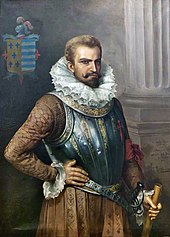
After they arrived in the New World, the Spanish started several expeditions to Guatemala, beginning in 1519. Before long, Spanish contact resulted in an epidemic that devastated native populations. Hernán Cortés, who had led the Spanish conquest of Mexico, granted a permit to Captains Gonzalo de Alvarado and his brother, Pedro de Alvarado, to conquer this land. Alvarado at first allied himself with the Kaqchikel nation to fight against their traditional rivals the K'iche' (Quiché) nation. Alvarado later turned against the Kaqchikel, and eventually brought the entire region under Spanish domination.[26]
During the colonial period, Guatemala was an audiencia, a captaincy-general (Capitanía General de Guatemala) of Spain, and a part of New Spain (Mexico).[27] The first capital, Villa de Santiago de Guatemala (now known as Tecpan Guatemala), was founded on 25 July 1524 near Iximché, the Kaqchikel capital city. The capital was moved to Ciudad Vieja on 22 November 1527, as a result of a Kaqchikel attack on Villa de Santiago de Guatemala. Owing to its strategic location on the American Pacific Coast, Guatemala became a supplementary node to the Transpacific Manila Galleon trade connecting Latin America to Asia via the Spanish owned Philippines.[28]
On 11 September 1541, the new capital was flooded when the lagoon in the crater of the Agua Volcano collapsed due to heavy rains and earthquakes; the capital was then moved 6 km (4 mi) to Antigua in the Panchoy Valley, now a UNESCO World Heritage Site. This city was destroyed by several earthquakes in 1773–1774. The King of Spain authorized moving the capital to its current location in the Ermita Valley, which is named after a Catholic church dedicated to the Virgen del Carmen. This new capital was founded on 2 January 1776.
Independence and Central America (1821–1847)
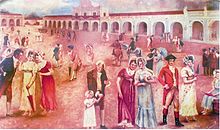
On 15 September 1821, Gabino Gainza Fernandez de Medrano and the Captaincy General of Guatemala, an administrative region of the Spanish Empire consisting of Chiapas, Guatemala, El Salvador, Nicaragua, Costa Rica, and Honduras, officially proclaimed its independence from Spain at a public meeting in Guatemala City. Independence from Spain was gained, and the Captaincy General of Guatemala joined the First Mexican Empire under Agustín de Iturbide.
Under the First Empire, Mexico reached its greatest territorial extent, stretching from northern California to the provinces of Central America (excluding Panama, which was then part of Colombia), which had not initially approved becoming part of the Mexican Empire but joined the Empire shortly after their independence. This region was formally a part of the Viceroyalty of New Spain throughout the colonial period, but as a practical matter had been administered separately. It was not until 1825 that Guatemala created its own flag.[29]
In 1838 the liberal forces of Honduran leader Francisco Morazán and Guatemalan José Francisco Barrundia invaded Guatemala and reached San Sur, where they executed Chúa Alvarez, father-in-law of Rafael Carrera, then a military commander and later the first president of Guatemala. The liberal forces impaled Alvarez's head on a pike as a warning to followers of the Guatemalan caudillo.[30] Carrera and his wife Petrona – who had come to confront Morazán as soon as they learned of the invasion and were in Mataquescuintla – swore they would never forgive Morazán even in his grave; they felt it impossible to respect anyone who would not avenge family members.[31]
After sending several envoys, whom Carrera would not receive – and especially not Barrundia whom Carrera did not want to murder in cold blood – Morazán began a scorched-earth offensive, destroying villages in his path and stripping them of assets. The Carrera forces had to hide in the mountains.[32] Believing Carrera totally defeated, Morazán and Barrundia marched to Guatemala City, and were welcomed as saviors by state governor Pedro Valenzuela and members of the conservative Aycinena clan, who proposed to sponsor one of the liberal battalions, while Valenzuela and Barrundia gave Morazán all the Guatemalan resources needed to solve any financial problem he had.[33] The criollos of both parties celebrated until dawn that they finally had a criollo caudillo like Morazán, who was able to crush the peasant rebellion.[34]
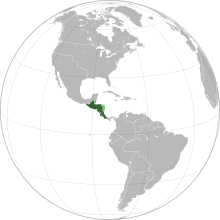
Morazán used the proceeds to support Los Altos and then replaced Valenzuela with Mariano Rivera Paz, a member of the Aycinena clan, although he did not return to that clan any property confiscated in 1829. In revenge, Juan José de Aycinena y Piñol voted to dissolve the Central American Federation in San Salvador a little later, forcing Morazán to return to El Salvador to fight for his federal mandate. Along the way, Morazán increased repression in eastern Guatemala, as punishment for helping Carrera.[35] Knowing that Morazán had gone to El Salvador, Carrera tried to take Salamá with the small force that remained, but was defeated, and lost his brother Laureano in combat. With just a few men left, he managed to escape, badly wounded, to Sanarate.[36] After recovering somewhat, he attacked a detachment in Jutiapa and got a small amount of booty which he gave to the volunteers who accompanied him. He then prepared to attack Petapa near Guatemala City, where he was victorious, although with heavy casualties.[37]
In September of that year, Carrera attempted an assault on the capital of Guatemala, but the liberal general Carlos Salazar Castro defeated him in the fields of Villa Nueva and Carrera had to retreat.[38] After unsuccessfully trying to take Quetzaltenango, Carrera found himself both surrounded and wounded. He had to capitulate to Mexican General Agustín Guzmán, who had been in Quetzaltenango since Vicente Filísola's arrival in 1823. Morazán had the opportunity to shoot Carrera, but did not, because he needed the support of the Guatemalan peasants to counter the attacks of Francisco Ferrera in El Salvador. Instead, Morazán left Carrera in charge of a small fort in Mita, without any weapons. Knowing that Morazán was going to attack El Salvador, Francisco Ferrera gave arms and ammunition to Carrera and convinced him to attack Guatemala City.[39]
Meanwhile, despite insistent advice to definitively crush Carrera and his forces, Salazar tried to negotiate with him diplomatically; he even went as far as to show that he neither feared nor distrusted Carrera by removing the fortifications of the Guatemalan capital, in place since the battle of Villa Nueva.[38] Taking advantage of Salazar's good faith and Ferrera's weapons, Carrera took Guatemala City by surprise on 13 April 1839; Salazar, Mariano Gálvez and Barrundia fled before the arrival of Carrera's militiamen. Salazar, in his nightshirt, vaulted roofs of neighboring houses and sought refuge,[40][41] reaching the border disguised as a peasant.[40][41] With Salazar gone, Carrera reinstated Rivera Paz as head of state.
Between 1838 and 1840 a secessionist movement in the city of Quetzaltenango founded the breakaway state of Los Altos and sought independence from Guatemala. The most important members of the Liberal Party of Guatemala and liberal enemies of the conservative régime moved to Los Altos, leaving their exile in El Salvador.[42] The liberals in Los Altos began severely criticizing the Conservative government of Rivera Paz.[42] Los Altos was the region with the main production and economic activity of the former state of Guatemala. Without Los Altos, conservatives lost many of the resources that had given Guatemala hegemony in Central America.[42] The government of Guatemala tried to reach a peaceful solution, but two years of bloody conflict followed.
On 17 April 1839, Guatemala declared itself independent from the United Provinces of Central America. In 1840, Belgium began to act as an external source of support for Carrera's independence movement, in an effort to exert influence in Central America. The Compagnie belge de colonisation (Belgian Colonization Company), commissioned by Belgian King Leopold I, became the administrator of Santo Tomas de Castilla[43] replacing the failed British Eastern Coast of Central America Commercial and Agricultural Company.[43] Even though the colony eventually crumbled, Belgium continued to support Carrera in the mid-19th century, although Britain continued to be the main business and political partner to Carrera.[44] Rafael Carrera was elected Guatemalan Governor in 1844.
Republicedit
On 21 March 1847, Guatemala declared itself an independent republic and Carrera became its first president.

Carrera government (1847–1851)edit
During the first term as president, Carrera brought the country back from extreme conservatism to a traditional moderation; in 1848, the liberals were able to drive him from office, after the country had been in turmoil for several months.[45][46] Carrera resigned of his own free will and left for México. The new liberal regime allied itself with the Aycinena family and swiftly passed a law ordering Carrera's execution if he returned to Guatemalan soil.[45]
The liberal criollos from Quetzaltenango were led by general Agustín Guzmán who occupied the city after Corregidor general Mariano Paredes was called to Guatemala City to take over the presidential office.[47] They declared on 26 August 1848 that Los Altos was an independent state once again. The new state had the support of Doroteo Vasconcelos' régime in El Salvador and the rebel guerrilla army of Vicente and Serapio Cruz, who were sworn enemies of Carrera.[48] The interim government was led by Guzmán himself and had Florencio Molina and the priest Fernando Davila as his Cabinet members.[49] On 5 September 1848, the criollos altenses chose a formal government led by Fernando Antonio Martínez.
In the meantime, Carrera decided to return to Guatemala and did so, entering at Huehuetenango, where he met with native leaders and told them that they must remain united to prevail; the leaders agreed and slowly the segregated native communities started developing a new Indian identity under Carrera's leadership.[50] In the meantime, in the eastern part of Guatemala, the Jalapa region became increasingly dangerous; former president Mariano Rivera Paz and rebel leader Vicente Cruz were both murdered there after trying to take over the Corregidor office in 1849.[50]
When Carrera arrived to Chiantla in Huehuetenango, he received two altenses emissaries who told him that their soldiers were not going to fight his forces because that would lead to a native revolt, much like that of 1840; their only request from Carrera was to keep the natives under control.[50] The altenses did not comply, and led by Guzmán and his forces, they started chasing Carrera; the caudillo hid, helped by his native allies and remained under their protection when the forces of Miguel Garcia Granados arrived from Guatemala City looking for him.[50]
On learning that officer José Víctor Zavala had been appointed as Corregidor in Suchitepéquez, Carrera and his hundred jacalteco bodyguards crossed a dangerous jungle infested with jaguars to meet his former friend. Zavala not only did not capture him, he agreed to serve under his orders, thus sending a strong message to both liberal and conservatives in Guatemala City that they would have to negotiate with Carrera or battle on two fronts – Quetzaltenango and Jalapa.[51] Carrera went back to the Quetzaltenango area, while Zavala remained in Suchitepéquez as a tactical maneuver.[52] Carrera received a visit from a cabinet member of Paredes and told him that he had control of the native population and that he assured Paredes that he would keep them appeased.[51] When the emissary returned to Guatemala City, he told the president everything Carrera said, and added that the native forces were formidable.[53]
Guzmán went to Antigua to meet with another group of Paredes emissaries; they agreed that Los Altos would rejoin Guatemala, and that the latter would help Guzmán defeat his enemy and also build a port on the Pacific Ocean.[53] Guzmán was sure of victory this time, but his plan evaporated when in his absence Carrera and his native allies occupied Quetzaltenango; Carrera appointed Ignacio Yrigoyen as Corregidor and convinced him that he should work with the K'iche', Q'anjobal and Mam leaders to keep the region under control.[54] On his way out, Yrigoyen murmured to a friend: "Now he is the king of the Indians, indeed!"[54]
Guzmán then left for Jalapa, where he struck a deal with the rebels, while Luis Batres Juarros convinced President Paredes to deal with Carrera. Back in Guatemala City within a few months, Carrera was commander-in-chief, backed by military and political support of the Indian communities from the densely populated western highlands.[55] During the first presidency, from 1844 to 1848, he brought the country back from excessive conservatism to a moderate regime, and – with the advice of Juan José de Aycinena y Piñol and Pedro de Aycinena – restored relations with the Church in Rome with a Concordat ratified in 1854.[56]
Second Carrera government (1851–1865)edit
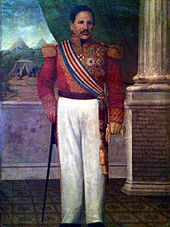
After Carrera returned from exile in 1849 the president of El Salvador, Doroteo Vasconcelos, granted asylum to the Guatemalan liberals, who harassed the Guatemalan government in several different ways. José Francisco Barrundia established a liberal newspaper for that specific purpose. Vasconcelos supported a rebel faction named "La Montaña" in eastern Guatemala, providing and distributing money and weapons. By late 1850, Vasconcelos was getting impatient at the slow progress of the war with Guatemala and decided to plan an open attack. Under that circumstance, the Salvadorean head of state started a campaign against the conservative Guatemalan regime, inviting Honduras and Nicaragua to participate in the alliance; only the Honduran government led by Juan Lindo accepted.[45] In 1851 Guatemala defeated an Allied army from Honduras and El Salvador at the Battle of La Arada.
In 1854 Carrera was declared "supreme and perpetual leader of the nation" for life, with the power to choose his successor. He held that position until he died on 14 April 1865. While he pursued some measures to set up a foundation for economic prosperity to please the conservative landowners, military challenges at home and a three-year war with Honduras, El Salvador, and Nicaragua dominated his presidency.
His rivalry with Gerardo Barrios, President of El Salvador, resulted in open war in 1863. At Coatepeque the Guatemalans suffered a severe defeat, which was followed by a truce. Honduras joined with El Salvador, and Nicaragua and Costa Rica with Guatemala. The contest was finally settled in favor of Carrera, who besieged and occupied San Salvador, and dominated Honduras and Nicaragua. He continued to act in concert with the Clerical Party, and tried to maintain friendly relations with European governments. Before he died, Carrera nominated his friend and loyal soldier, Army Marshall Vicente Cerna y Cerna, as his successor.
Vicente Cerna y Cerna regime (1865–1871)edit

Vicente Cerna y Cerna was president of Guatemala from 24 May 1865 to 29 June 1871.[57] Liberal author Alfonso Enrique Barrientos,[58] described Marshall Cerna's government in the following manner:[58]
A conservative and archaic government, badly organized and with worse intentions, was in charge of the country, centralizing all powers in Vicente Cerna, ambitious military man, who not happy with the general rank, had promoted himself to the Army Marshall rank, even though that rank did not exist and it does not exist in the Guatemalan military. The Marshall called himself President of the Republic, but in reality he was the foreman of oppressed and savaged people, cowardly enough that they had not dared to tell the dictator to leave threatening him with a revolution.
The State and Church were a single unit, and the conservative régime was strongly allied to the power of regular clergy of the Catholic Church, who were then among the largest landowners in Guatemala. The tight relationship between church and state had been ratified by the Concordat of 1852, which was the law until Cerna was deposed in 1871.[59] Even liberal generals like Serapio Cruz realized that Rafael Carrera's political and military presence made him practically invincible. Thus the generals fought under his command,[45] and waited—for a long time—until Carrera's death before beginning their revolt against the tamer Cerna.[60] During Cerna's presidency, liberal party members were prosecuted and sent into exile; among them, those who started the Liberal Revolution of 1871.[45]
In 1871, the merchants guild, Consulado de Comercio, lost their exclusive court privilege. They had major effects on the economics of the time, and therefore land management. From 1839 to 1871, the Consulado held a consistent monopolistic position in the regime.[61]
Liberal governments (1871–1898)edit
Guatemala's "Liberal Revolution" came in 1871 under the leadership of Justo Rufino Barrios, who worked to modernize the country, improve trade, and introduce new crops and manufacturing. During this era coffee became an important crop for Guatemala.[62] Barrios had ambitions of reuniting Central America and took the country to war in an unsuccessful attempt to attain it, losing his life on the battlefield in 1885 against forces in El Salvador.
Manuel Barillas was president from 16 March 1886 to 15 March 1892. Manuel Barillas was unique among liberal presidents of Guatemala between 1871 and 1944: he handed over power to his successor peacefully. When election time approached, he sent for the three Liberal candidates to ask them what their government plan would be.[63] Happy with what he heard from general Reyna Barrios,[63] Barillas made sure that a huge column of Quetzaltenango and Totonicapán indigenous people came down from the mountains to vote for him. Reyna was elected president. [64]
José María Reina Barrios was president between 1892 and 1898. During Barrios's first term in office, the power of the landowners over the rural peasantry increased. He oversaw the rebuilding of parts of Guatemala City on a grander scale, with wide, Parisian-style avenues. He oversaw Guatemala hosting the first "Exposición Centroamericana" ("Central American Fair") in 1897. During his second term, Barrios printed bonds to fund his ambitious plans, fueling monetary inflation and the rise of popular opposition to his regime.
His administration also worked on improving the roads, installing national and international telegraphs and introducing electricity to Guatemala City. Completing a transoceanic railway was a main objective of his government, with a goal to attract international investors at a time when the Panama Canal was not yet built.
Manuel Estrada Cabrera regime (1898–1920)edit

After the assassination of general José María Reina Barrios on 8 February 1898, the Guatemalan cabinet called an emergency meeting to appoint a new successor, but declined to invite Estrada Cabrera to the meeting, even though he was the designated successor to the presidency. There are two different descriptions of how Cabrera was able to become president. The first states that Cabrera entered the cabinet meeting "with pistol drawn" to assert his entitlement to the presidency,[65] while the second states that he showed up unarmed to the meeting and demanded the presidency by virtue of being the designated successor.[66]
The first civilian Guatemalan head of state in over 50 years, Estrada Cabrera overcame resistance to his regime by August 1898 and called for elections in September, which he won handily.[67] In 1898 the legislature convened for the election of President Estrada Cabrera, who triumphed thanks to the large number of soldiers and policemen who went to vote in civilian clothes and to the large number of illiterate family that they brought with them to the polls.[68]
One of Estrada Cabrera's most famous and most bitter legacies was allowing the entry of the United Fruit Company (UFCO) into the Guatemalan economic and political arena. As a member of the Liberal Party, he sought to encourage development of the nation's infrastructure of highways, railroads, and sea ports for the sake of expanding the export economy. By the time Estrada Cabrera assumed the presidency there had been repeated efforts to construct a railroad from the major port of Puerto Barrios to the capital, Guatemala City. Owing to lack of funding exacerbated by the collapse of the internal coffee trade, the railway fell 100 kilometres (60 mi) short of its goal. Estrada Cabrera decided, without consulting the legislature or judiciary, that striking a deal with the UFCO was the only way to finish the railway.[69] Cabrera signed a contract with UFCO's Minor Cooper Keith in 1904 that gave the company tax exemptions, land grants, and control of all railroads on the Atlantic side.[70]
In 1906 Estrada faced serious revolts against his rule; the rebels were supported by the governments of some of the other Central American nations, but Estrada succeeded in putting them down. Elections were held by the people against the will of Estrada Cabrera and thus he had the president-elect murdered in retaliation. In 1907 Estrada narrowly survived an assassination attempt when a bomb exploded near his carriage.[71] It has been suggested that the extreme despotic characteristics of Estrada did not emerge until after an attempt on his life in 1907.[72]
Guatemala City was badly damaged in the 1917 Guatemala earthquake.
Estrada Cabrera continued in power until forced to resign after new revolts in 1920. By that time his power had declined drastically and he was reliant upon the loyalty of a few generals. While the United States threatened intervention if he was removed through revolution, a bipartisan coalition came together to remove him from the presidency. He was removed from office after the national assembly charged that he was mentally incompetent, and appointed Carlos Herrera in his place on 8 April 1920.[73]
Guatemala joined with El Salvador and Honduras in the Federation of Central America from 9 September 1921 until 14 January 1922.
Carlos Herrera served as President of Guatemala from 1920 until 1921. He was succeeded by José María Orellana, who served from 1921 until 1926. Lázaro Chacón González then served until 1931.
Zdroj:https://en.wikipedia.org?pojem=Administrative_divisions_of_Guatemala
Text je dostupný za podmienok Creative Commons Attribution/Share-Alike License 3.0 Unported; prípadne za ďalších podmienok. Podrobnejšie informácie nájdete na stránke Podmienky použitia.
Antropológia
Aplikované vedy
Bibliometria
Dejiny vedy
Encyklopédie
Filozofia vedy
Forenzné vedy
Humanitné vedy
Knižničná veda
Kryogenika
Kryptológia
Kulturológia
Literárna veda
Medzidisciplinárne oblasti
Metódy kvantitatívnej analýzy
Metavedy
Metodika
Text je dostupný za podmienok Creative
Commons Attribution/Share-Alike License 3.0 Unported; prípadne za ďalších
podmienok.
Podrobnejšie informácie nájdete na stránke Podmienky
použitia.
www.astronomia.sk | www.biologia.sk | www.botanika.sk | www.dejiny.sk | www.economy.sk | www.elektrotechnika.sk | www.estetika.sk | www.farmakologia.sk | www.filozofia.sk | Fyzika | www.futurologia.sk | www.genetika.sk | www.chemia.sk | www.lingvistika.sk | www.politologia.sk | www.psychologia.sk | www.sexuologia.sk | www.sociologia.sk | www.veda.sk I www.zoologia.sk



